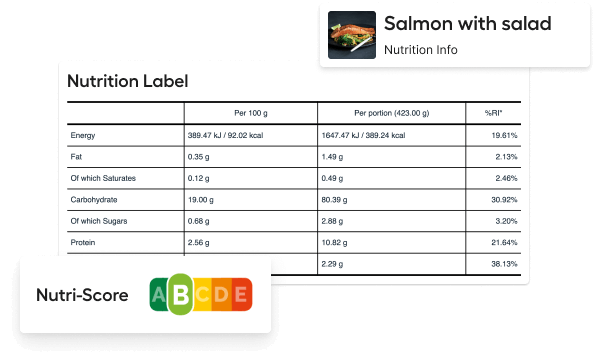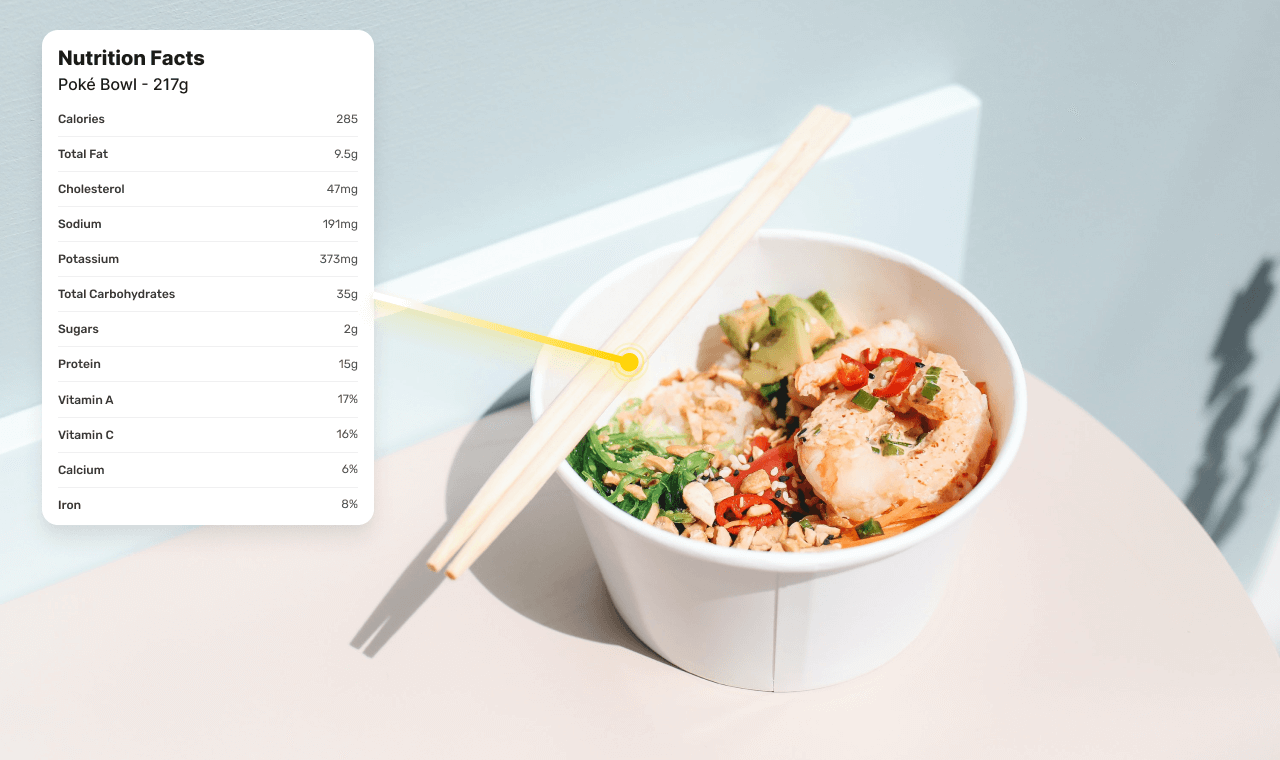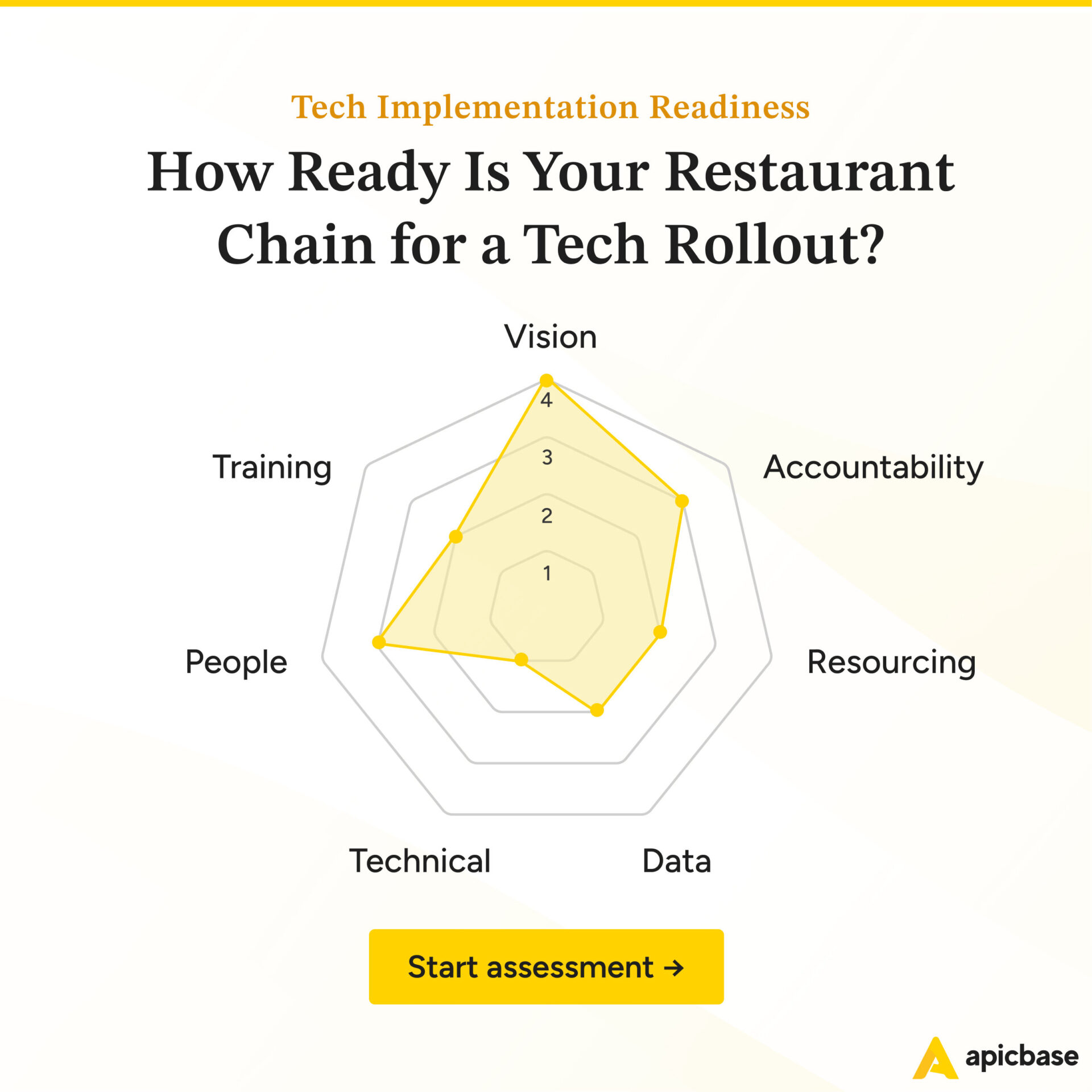From 6th April 2022, certain food businesses in England have to display the calorie content of the food they sell.
The new law regarding calorie information applies to large out of home businesses with more than 250 employees, including caterers, restaurants, cafés and takeaways.
The new measure is a weapon for the government’s fight against obesity, and childhood obesity in particular. Calorie labelling should help consumers make more informed food choices.
In this article, you’ll learn:
- Why the government made calorie information labels mandatory
- If the calorie labelling regulation applies to your business
- Which food businesses are exempt from displaying calorie labels
- What foods require labelling
- What foods are exempt from calorie labelling
- How to display calorie information
- How to calculate the calories of a dish or menu
- Benefits of calorie labelling
- Challenges of calorie calculations for menus
Skip the read and find out if you have to provide calorie information to your customers.
Download the Calorie Labelling Flowchart for Restaurant Operators.
Why Has The Government Made Calorie Information Labels Mandatory
The reason for the new regulation is the alarming increase in obesity in the population.
Childhood obesity rates in the UK are among the highest in Western Europe. Almost 25% of children in England start primary school overweight or obese, and the number rises to 33% by they turn 11 years old.
Obese children are more likely to become obese adults, and obesity in adulthood increases the risk of developing type 2 diabetes, heart disease, fatty liver disease, and many cancers.
⅓ of 11-year-olds is overweight or obese.
The overconsumption of calories leads people to become overweight or obese. And we are not even talking about eating monstrously large quantities of food. Regularly eating a little too much can be enough to become overweight.
As it turns out, research reveals that a lot of these excess calories come from out-of-home meals. The difference between a takeaway meal and a meal prepared at home amounts to about 200 calories a day.
According to a survey, 43% eat out at least once or twice a week. So it makes sense for the government to want to inform people of the high-calorie content of these dishes—and nudge food manufacturers towards the production of healthier foods.
43% of people in the UK eat out at least once or twice a week.
Incidentally, the government isn’t alone in being concerned about the rising obesity rate in the country.
The general public is on board with calorie labelling as well. 79% of respondents to a Public Health England survey said that menus should include the number of calories in food and drinks. Another study from Diabetes UK showed that around 60% of the public said they would be more likely to eat at an establishment that offered calorie labelling on its menus.
Food businesses are aware of the growing customer demand for nutritional information, and many are already displaying calorie labels on their menu items.
With the new calorie labelling legislation, the government takes the obesity challenge head-on.
When Will The Calorie Law Be Effective?
6th of April 2022
What if I Don’t Comply?
The penalties are pretty serious. Trading Standards Officers may impose an ‘improvement notice’ in the event of a breach of regulations. This is basically a warning, giving a venue two weeks to do better. If they fail to up their game, these operations face fines of up to £2,500 or even criminal proceedings.
Does The New Calorie Legislation Apply To My F&B Operation?
The answer is yes if you run a business with 250 employees or more that sells non-prepacked food or drink meant for immediate consumption by the people who buy it.
There are a few exceptions, though. Use the flowchart to determine if you need to comply to the new calorie labeling regulation.
These are examples of types of food operations that need to comply with the new law regarding food labels:
- Restaurants, fast food outlets, cafes, pubs and supermarkets
- Home delivery services and third-party apps selling food that is within the scope
- Cafes and takeaways within larger shops and venues, such as supermarkets, department stores, and entertainment venues such as cinemas
- Specialist food stores, delicatessens, sweet shops and bakeries
- Contract catering – for example, for events and canteens (see mass catering subsection below)
- Domestic transport businesses, including planes, trains, ferries and other forms of water transport within the UK
Are part-time employees included in the headcount?
Yes, they are. The definition of an employee in the Regulations is someone who has a contract for full-time or part-time work. So, part-time staff should be included as part of the headcount.
Let’s take a look at specific business types in the foodservice industry.
Do Multi-Unit Restaurant Operations Need To Have Calorie Labelling On Their Menus
Restaurant chains need to inform their customers about the calories of individual menu items when the total number of staff equals or exceeds 250. Calorie labelling isn’t mandatory for smaller food service operations with a smaller workforce.
Do Restaurant Franchises Need To Comply With The Calorie Labeling Legislation?
Franchised foodservice businesses are in a particular situation because of the distinction between franchisor and franchisee. They are independent enterprises that share certain business elements or address them jointly.
How does the employee headcount requirement work in a franchise situation? The law is clear on this point.
A franchisee is treated as part of the franchisor and not as a separate business.
In other words, when you are a franchisee, and the number of employees across the whole franchise network is 250 or more, you will be required to calorie label. Since you are selling the food, it is your responsibility, as a franchisee, to ensure that the calorie information is displayed following the new regulations.
There is, however, an exemption. The rule doesn’t apply if the franchise agreement is limited to alcohol, and the franchisee can determine what other food is provided. Some pubs, for example, have such a franchise agreement.
I Sell Food Online For Delivery, Does The Calorie Regulation Affect My Business?
Yes, it does. In all circumstances, regardless of the number of employees, when you sell food online, on a website or a mobile application, including third-party delivery apps (or food delivery platforms), you have to provide calorie information to your customers. To be clear, the business providing the food needs to provide the calorie information for display on the website or mobile application.
I Am A Contract Caterer. Do I Need To Display Calorie Information?
Yes, you do, if you have 250 or more employees. The rule applies to
- an educational institution for those over 18 years old
- a military establishment
- criminal justice accommodation
- a hospital or other medical institution
- a care home or other institution providing social care
- a canteen at a workplace providing food to employees
My Menus Change Regularly, Do I Need To Comply With The New Legislation?
Food that is temporarily on the menu doesn’t require calorie labelling, even when you have more than 250 employees. In this case, temporarily means less than 30 consecutive days and a total of 30 days in any year.
Why not?
It’s an exemption to allow flexibility for businesses to use temporary menu items to help reduce their food waste, use seasonal produce and offer special menu items at specific points of the year.
What if a customer asks for preparation outside the menu?
In that case, calorie information isn’t mandatory. Food that is not included on the menu or otherwise offered for sale and requested expressly by the consumer to be made available or prepared differently from how it is usually made is exempt from the new regulation.
Example
When a customer asks for extra cheese on a burger, calorie information isn’t required when that option isn’t on the menu.
Find out if you have to provide calorie information to your customers.
Download the Calorie Labelling Flowchart for Restaurant Operators.
Which Food Items Require Calorie Labelling?
Food in the scope of the Regulations and therefore requiring calorie labelling is food that is:
- offered for sale in a form suitable for immediate consumption
- not prepacked food
What is Food For Immediate Consumption?
Food for immediate consumption is food or drink that is either:
- offered for sale for consumption on the premises
- offered for sale for consumption off the premises and does not require any preparation by the consumer before it is eaten or drunk (preparation includes peeling, hulling or washing, cooking, thawing and heating or reheating pre-cooked food)
For which Foods Calorie Labelling Isn’t Mandatory
The following foods are exempt from calorie labelling:
- Fresh fruit or vegetables, including potatoes, provided that they are not added to other food or sold as an ingredient in food consisting of more than one ingredient.
Example
Loose fruit in a supermarket is exempt unless part of a fruit salad. Then it must be calorie labelled. - Unprocessed products consisting of a single ingredient.
Example
Herbs, nuts and seeds are examples of single-ingredient items that are not considered fruits or vegetables. - Fish, meats or cheese, provided that the fish, meat or cheese is not added to other food or sold as an ingredient in food consisting of more than one ingredient.
Example
Sliced ham, rotisserie chicken or smoked salmon from a fish or meat counter are examples of items that do not need to be calorie labelled if offered for sale for consumption off-premises. However, calorie information must be displayed when fish, meat or cheese is sold as an ingredient in food, such as fish as part of a sushi platter or chicken as an ingredient in a ‘build your own’ sandwich. - Loaf of bread or baguette (rolls or buns do require calorie labelling)
Example
Loaves of bread (including bread with additional ingredients such as seeds or olives) fall under this exemption and do not need to be calorie labelled. However, rolls or buns do not fall under the exemption for loaves and require calorie labelling.
Food or Drink For Particular Audiences Is Exempt
- food that is provided by a charity, in the course of its charitable activities, free, or for a price which is less than the cost of providing that food; or offered for sale by or on behalf of a charity, at a single event, to raise funds for its charitable activities.
- food that is provided at an educational institution for pupils below the age of 18 years old.
- food provided (not for payment) to patients at a hospital or other medical establishment, or to residents of a care home or other social care institution.
- food served by the armed forces to a member of the armed forces outside a military canteen
- food that is served on international transport (on an aircraft, a train or a ferry) to or from a country that is not part of the United Kingdom.
Displaying Calorie Information
Calorie information must be displayed at the point of choice. This is the location where a customer chooses what food to purchase. The information must be clearly visible, and there can be no misunderstanding about which food the label refers to.
Suppose an establishment has multiple points of choice—a menu on the premises, a display case on the premises, and an online menu. In that case, calorie information is required at each location.
What information should be given to the customer?
- display the energy content of the food in kilocalories (kcal)
- reference the size of the portion to which the calorie information relates
- display the statement that ‘adults need around 2000 kcal a day’.
I have ‘build your own’ and ‘meal deals’. What do I do?
Suppose you have a ‘build your own’ sandwich shop, for example. In that case, you could provide calorie information for the base product, the bread, along with calorie information for a standard portion for each of the potential additions the customer could add to the sandwich.
A business selling meal deals could provide calorie information for each of the individual items the customer could choose from as part of their meal deal, instead of providing calorie information for all potential combinations.
How To Calculate Calories In Food?
The formula for calculating the calorie content of food is pretty straightforward:
- Take a recipe
- List the ingredients
- Look up the calorie value of each ingredient in the official CoFID database of Public Health England.
- Calculate the number of calories for one serving of the recipe by adding the number of calories in proportion to the quantities of ingredients used.
Businesses should develop and implement processes to ensure that calorie information is as accurate as possible to ensure the food can be reproduced consistently each time it is made.
However, given the inherent variation in ingredients, processing of foods, and exact portion size, a tolerance of plus or minus 20% is considered an acceptable margin of difference between actual and declared calorie values.
What is a calorie?
The amount of energy in an item of food or drink is measured in calories.
When we eat and drink more calories than we use up, our bodies store the excess as body fat. If this continues, over time, we may put on weight.
Kcal stands for kilocalorie. A kilocalorie is another word for what’s commonly called a calorie, so 1,000 calories will be written as 1,000 kcals.
On nutritional labels, calorie totals sit in the ‘Energy’ column.
Benefits of Calorie Labelling On Menus
- For foodservice brands, nutritional labelling is a way of communicating with the customer, which contributes to establishing a solid relationship with the brand.
- For the consumer, nutritional information helps make informed decisions about eating and drinking. Healthier food choices lead to better well-being and improved quality of life.
- For the English government, the food labels are a weapon in the fight against the rising obesity rates and the tremendous pressure it puts on the UK health system.
Challenges of Calorie Labelling On Menus
Nutritional labels don’t fall into an easy ‘set it and forget it’ bucket. It’s a time-consuming and complicated chore.
The calorie information has to be collected for each recipe and the values calculated. The calorie count must then be put into a clear and readable format and made available at every point of choice (on-premises and online).
Every time the menu changes or a single recipe is modified, the whole exercise starts again.
Automate Calorie Labelling With Apicbase
If you want to offer your customers excellent service and comply with the new nutrition labelling regulations without performing manual calorie calculations, it is worth considering Apicbase.

Apicbase is a leading F&B management platform. Large restaurant, hotel, and catering groups rely on the system to automate their back of house operations, including nutritional value calculations.
Apicbase leverages the calorie information from official nutrition databases to calculate the nutritional values for individual recipes and menus. It generates printable labels that follow the official formatting rules.
For businesses with online ordering apps, digital kiosks or tablets, Apicbase offers open APIs. This way, the menu information available to the customer is automatically updated in real-time. Apicbase is the backbone of large-scale foodservice operations worldwide.
Find out if you have to provide calorie information to your customers.
Download the Calorie Labelling Flowchart for Restaurant Operators.



